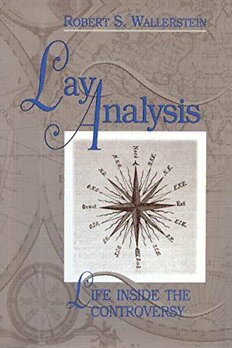
Lay Analysis: Life Inside the Controversy PDF
Preview Lay Analysis: Life Inside the Controversy
LAY ANALYSIS Life Inside the Controversy Robert S. Wallerstein, M.D. LAY ANALYSIS Life Inside the Controversy Robert S . Wallerstein ~~ ~~o~J~~n~~~up New York London © 1998 by The Analytic Press, Inc., Publishers All rights reserved. No part of this book may be reproduced, stored, or transmitted in any way whatsoever without the prior written permission of the publisher. First Published by The Analytic Press, Inc. 101 West Street, Hillsdale, New Jersey 07642 This edition published 2012 by Routledge Routledge Routledge Taylor & Francis Group Taylor & Francis Group 711 Third Avenue 27 Church Road, Hove New York, NY 10017 East Sussex BN3 2FA Index by Leonard S. Rosenbaum Library of Congress Cataloging-in-Publication Data Wallerstein, Robert S. Lay analysis : life inside the controversy I Robert S. Wallerstein p. em. Includes bibliographical references and index. ISBN: 0-88163-285-6 1. Welch, Bryant, 1946- -Trials, litigation, etc. 2. American Psychoanalytic Association-Trials, litigation, etc. 3. International Psycho-Analytical Association-Trials, litigation, etc. 4. Lay analysis (Psychoanalysis)-Law and legislation--United States. 5. Lay analysis (Psychoanalysis)-History. I. Title. KF228.W413W35 1998 98-46417 150.19'5'0801-dc21 CIP To my beloved grandchildren, Jonah, Hannah, Benjamin, Alexei, and Nicole, from their proud and admiring grandfather. I believe that to solve any problem that has never been solved before, you have to leave the door ajar. You have to permit the possibility that you do not have it exactly right. Richard P. Feynman The Meaning of It All: Thoughts of a Citizen Scientist Contents Preface tX Acknowledgments Xttt 1 The Origins of the Qyestion of Lay Analysis: The Development in Europe 1 2 The Confrontation from America and the "1938 Rule" 23 3 The Post-World War II Resolution of the Crisis 51 4 My Life into Psychoanalysis 75 5 Training for Research: The First Crack in the Door 95 6 The Four Committees of the American and the Precipitation of the Lawsuit 113 7 My Career in the IPA and the Filing of the Lawsuit 137 8 The First Year of the Lawsuit 159 9 The Settlement Negotiations that Failed: April to October 1986 183 10 Averting a Split: Agreement between the American and the IPA, December 1986 207 11 Revision of the "1938 Agreement," July 1987: The End of a Half-Century of Controversy 237 12 The Clash over Class Certification: October 1987-February 1988 261 13 The Settlement Agreement: October 1988 285 14 The 1989 IPA Congress: Resolution of the Issue 313 15 Struggles over Implementation, 1989-1990 335 16 Further Struggles over Implementation, 1990-1991 361 17 Subsidence of the Legal Threat 387 18 The Story Brought to Date, 1996 411 19 The Meaning of the Controversy: The Identity of Psychoanalysis 443 Vll viii / Contents References 457 Archives: British Psychoanalytical Society: Chapters 2 and 3 463 Bulletins oft he International Psychoanalytical Association: Chapters 2 and 3 464 Committee on the Prerequisites for Training (CPT) oft he Board on Professional Standards (BOPS): Chapter 6 465 Further Documentation: Chapter 6 465 Documentation for Chapters 7 through 18 466 List of Organizations Involved in the Lawsuit, Its Precursors, and Its Aftermath 478 List ofI ndividuals Involved in the Lawsuit, Its Precursors, and Its Aftermath 479 Index 487 Preface The Conception of This Book A, ~iting of thi• (1995-1996), psychoanalysis as a science and profession is almost exactly 100 years old. Sigmund Freud's defining Studies on Hysteria, written in collaboration with Josef Breuer, bears the publication dates, 1893-1895. Even prior to that, Freud had published a number of forerunner papers on hypnotism and suggestion over the years 1888 to 1892 (Standard Edition, Vol. 1), and over the decade of the 1890s he published a variety of early psychoanalytic papers on hysteria, on phobias and obsessions, on neurasthenia and "anxiety neurosis," on the "neuro-psychoses of defence," on sexuality, on forgetting, and on screen memories (Standard Edition, Vol. 3). Together, these early publications in the decade of the 1890s limned the outlines of this daring new science of the mind and established the fundaments of a professional practice designed to ameliorate and reverse the mental and emotional ills to which the mind is subject. Over the succeeding decades, until his death at 83 in 1939, Freud progressively enlarged and also substantially altered both his theory of the development and functioning of the mind and his technique for therapeutically addressing its ills. By the time of his death he left, in his Gesammelte Werke, a corpus of work he had singlehandedly created, which, if no further contributions were to be made by any others, would still by itself constitute an adequate enough theory of normal and abnormal mental functioning and a viable enough mental healing technique. In all, Freud's labors spanned just a few years short of the first half-century of psychoanalysis. My own entry into psychiatric residency training with the explicit intention to become a psychoanalyst was in January 1949, just a few years after the start of the second half-century of psychoanalytic work. At that point I began to read the psychoanalytic literature, beginning with Freud, after an initial orientation via a first book by an author other than Freud, Psychotherapy in Medical Practice (1942), by Maurice Levine, the lX
